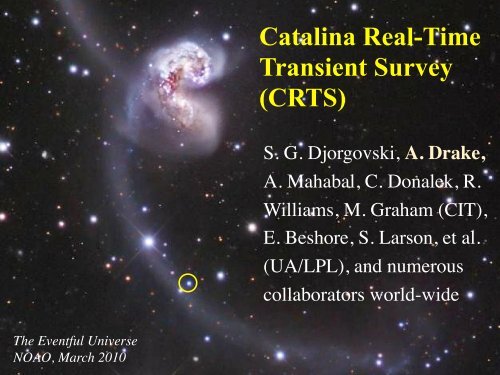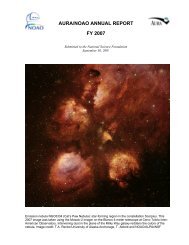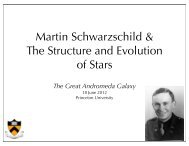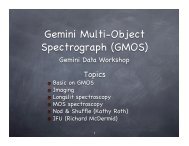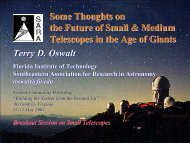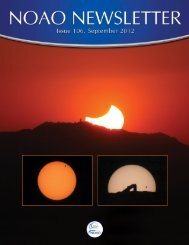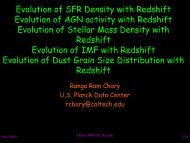Exploring the Time Domain With the Catalina Real-Time Transient ...
Exploring the Time Domain With the Catalina Real-Time Transient ...
Exploring the Time Domain With the Catalina Real-Time Transient ...
Create successful ePaper yourself
Turn your PDF publications into a flip-book with our unique Google optimized e-Paper software.
The Eventful Universe<br />
NOAO, March 2010<br />
<strong>Catalina</strong> <strong>Real</strong>-<strong>Time</strong><br />
<strong>Transient</strong> Survey<br />
(CRTS)<br />
S. G. Djorgovski, A. Drake,<br />
A. Mahabal, C. Donalek, R.<br />
Williams, M. Graham (CIT),<br />
E. Beshore, S. Larson, et al.<br />
(UA/LPL), and numerous<br />
collaborators world-wide
<strong>Catalina</strong> <strong>Real</strong>-<strong>Time</strong> <strong>Transient</strong> Survey<br />
CRTS uses <strong>the</strong><br />
data from all three<br />
<strong>Catalina</strong> NEO<br />
surveys, with a<br />
coverage of up to<br />
2,500 deg 2 / night,<br />
and <strong>the</strong> total area<br />
coverage of<br />
~ 30,000 deg 2<br />
We are processing <strong>the</strong> <strong>Catalina</strong> data streams in real time<br />
to look for astrophysical transients
CSS coverage<br />
as of Sep. 2008<br />
http://crts.caltech.edu
CRTS Coverage Map (CSS only)<br />
As of <strong>the</strong> early 2010, over 1200 unique transients discovered<br />
Red = SN, Blue = CV, Green = Blazar, Magenta = O<strong>the</strong>r<br />
• Discovery rate ~ 1 transient per 10 6 sources detected per epoch<br />
• Amplitude threshold deliberately set high, but can be lowered
Some Good Things About CRTS<br />
• <strong>Real</strong>-time processing, detection, and publishing of transients<br />
– Builds on <strong>the</strong> work started in <strong>the</strong> PQ survey (science & technology)<br />
• Added value for <strong>the</strong> data from <strong>the</strong> <strong>Catalina</strong> NEO surveys<br />
– Focus on astrophysical transients, a systematic exploration of<br />
<strong>the</strong> time domain, and <strong>the</strong> computational infrastructure<br />
• It is a fully open survey: all data are made public instantly,<br />
with no proprietary period at all<br />
– Benefits <strong>the</strong> entire community<br />
– Maximizes <strong>the</strong> follow-up and <strong>the</strong> resulting science<br />
– A new “open data” sociology – <strong>the</strong> shifting focus from <strong>the</strong><br />
ownership of data to <strong>the</strong> ownership of expertise<br />
• Public outreach via <strong>the</strong> Google’s Sky, MSR’s WorldWide<br />
Telescope, and “Citizen Science”<br />
• Supported by <strong>the</strong> NSF, NASA, and private gifts
Examples of CRTS <strong>Transient</strong>s<br />
CSS090429:135125-075714<br />
Probable flare star<br />
CSS090429:101546+033311<br />
Probable dwarf nova<br />
CSS090426:074240+544425<br />
Blazar, 2EG J0744+5438
Sample Light Curves<br />
Blazar PKS0823+033<br />
CV 111545+425822<br />
Supernova<br />
The plan is to produce light curves for every detected source in<br />
<strong>the</strong> survey (> 10 8 sources), make <strong>the</strong>m publicly available, and<br />
mine that data set. Light curves are generated on demand for<br />
transient sources, blazars, etc.
<strong>Real</strong> <strong>Time</strong> Event Publishing via VOEvents<br />
and SkyAlert (The successor of VOEventNet)<br />
PI: R. Williams<br />
http://skyalert.org
SkyAlert: Links to <strong>the</strong><br />
Including <strong>the</strong> VO<br />
DataScope, etc.<br />
Archival Data
CRTS events in<br />
WorldWide Telescope
Annotated Table of <strong>Transient</strong>s<br />
http://nesssi.cacr.caltech.edu/catalina/Allns.html
Selected transients and<br />
follow-up also published<br />
in ATel and CBET<br />
Many also picked up by VSNET
Follow-Up Observations:<br />
CSS090421:174806+340401<br />
A blazar, also monitored at<br />
OVRO in radio<br />
CRTS<br />
Lead: A. Mahabal<br />
• Photometry (P60, NMSU, DAO, HTN, India, soon Mexico)<br />
• Spectroscopy (Gemini N+S, Keck, P200, SMARTS, IGO, MDM)<br />
22 Apr 09 UT 13 May 09 UT<br />
P60
Some Results from CRTS<br />
To date: Over 1200 confirmed, unique transients discovered<br />
(some are detected repeatedly), including:<br />
• Over 300 SNe, including some ultraluminous ones<br />
• Over 300 CVs, ~ 75% previously unknown, some novae<br />
• Over 50 blazars, many previously unknown<br />
• About 50 flaring UV Ceti stars (CRTS has a 10 min time cadence)<br />
• Many o<strong>the</strong>r, high-amplitude variable stars, etc.; many unknown<br />
Fast transient (a flare star), CSS080118:112149–131310<br />
4 individual exposures, separated by 10 min Light curve
CRTS Supernova Discoveries<br />
• More SNe published in 2009 than any o<strong>the</strong>r survey<br />
• Extremely luminous and possible pair-production SNe (e.g.,<br />
SN 2007bi, 2008fz, 2009jh)<br />
• Extremely long time-scale SNe,<br />
e.g., 2008iy<br />
• SNe associated with very faint<br />
host galaxies<br />
Discovery<br />
Baseline<br />
CRTS<br />
hosts<br />
SNF<br />
hosts<br />
CSS 071218:120153-185822 = SN<br />
2007sr: Ia in <strong>the</strong> Antennae merger
2008fz: The Most Luminous Supernova?<br />
• Brightest type IIn known (5 times brighter than <strong>the</strong> Milky Way)<br />
• Host galaxy<br />
> 50 times<br />
fainter than<br />
Milky Way<br />
(Drake et al. 2009)<br />
Normal SN Ia<br />
Discovery<br />
Comparison
The Unusual SN 2008iy = CSS080928:160837+041627<br />
Longest-lasting type IIn at z = 0.041<br />
(Catelan et al., CBET 1780): it took<br />
> 400 days to reach <strong>the</strong> peak!<br />
12 Jun 07 UT 31 Jan 08 UT<br />
08 Apr 08 UT 20 Sep 08 UT<br />
25 Apr 09 UT 18 Aug 09 UT
The Slow SN 2008iy<br />
Host galaxy > 500 times fainter than <strong>the</strong><br />
Milky Way (~ 23 mag, M ≈ −13)<br />
Possibly from a LBV (~ η Carinae)<br />
progenitor: expanding SN interacts<br />
with material from past outbursts<br />
CTIO spectrum, age ~ 500 days<br />
SDSS coadd<br />
GALEX NUV:<br />
17 May 2004 UT<br />
05 Jun 2008 UT
Blazar Flares: A Recent Example<br />
CRATES J100110+291130 = CSS091118:100110+291130<br />
18 Nov 09 UT:<br />
15.75 mag<br />
16 Oct 09 UT:<br />
17.15 mag
Blazar Flares: Mining <strong>the</strong> Archival Data<br />
NVSS J012612+113009 =<br />
CSS091110:012612+113016<br />
SDSS<br />
g = 21.8 mag<br />
r = 21.3 mag<br />
PQ r<br />
PQ I<br />
NVSS FGST<br />
• Correlating blazar light curves from <strong>the</strong> visible, radio, and γrays,<br />
in order to constrain physical models<br />
• <strong>Real</strong>-time correlated blazar flare discovery with CRTS+FGST
Discovery of a New FU Ori Object<br />
10 Nov 09 UT:<br />
12.6 mag<br />
18 Jan 05 UT:<br />
14.8 mag<br />
CFHT image<br />
IRAS 06068–0641 =<br />
CSS091110:060919–064155<br />
Wils et al. ATel 2307<br />
CTIO spectrum
Eclipsing White Dwarfs: Planets?<br />
• Color-selected sample of WD candidates from CRTS + SDSS<br />
• Light curves from CRTS: looking for eclipses<br />
• Companion radii as low as a few Earth radii<br />
• Some could be ~ Earth-size planets; or late-M/brown dwarfs;<br />
IR spectroscopy will tell<br />
(Drake et al. 2009)
Coadded Images From MLS (1.5m)<br />
SDSS CRTS<br />
Combining <strong>the</strong> data from CRTS and PQ (DeepSky), we will have a<br />
reference sky coverage of ~ 3π sterad to <strong>the</strong> depth of r > 23 mag, and<br />
<strong>the</strong> light curves (detections or upper limits) for all detected sources
Automated Classification of <strong>Transient</strong>s<br />
A critical and growing need for synoptic sky surveys<br />
• Efforts started with <strong>the</strong> PQ survey, now<br />
continuing with CRTS and soon PTF<br />
o Collaboration with CS experts: M. Turmon, B.<br />
Moghaddam (JPL), D. Heckerman (MSR), o<strong>the</strong>rs<br />
• <strong>Exploring</strong> Bayesian Nets, Gaussian Process<br />
Regression; also using Neural Nets for selected<br />
tasks; Markov Logic Chains, MAB, etc.<br />
• A key importance of <strong>the</strong> contextual information:<br />
e.g., presence of <strong>the</strong> possible host galaxies, Gal.<br />
latitude, past light curve…<br />
o Very hard to encode in <strong>the</strong> traditional ML methods<br />
o Harvesting human pattern recognition through <strong>the</strong><br />
“citizen science” projects
Crowdsourcing / Citizen Science<br />
Harvesting <strong>the</strong> human pattern recognition skills
Summary<br />
• CRTS is producing a steady stream of transients, including<br />
blazars, SNe, CVs, etc.<br />
– All events are published in real time, with no proprietary period<br />
– All data (images, catalogs, lightcurves) will be made public<br />
– <strong>Time</strong> baselines from 10 min to several years<br />
– CSS+MLS+SSS coverage up to ~ 2500 deg 2 daily, 4 exposures<br />
per field, ~ 30,000 deg 2 total, hundreds of epochs<br />
• We can follow up only a modest fraction; this is a problem<br />
which will plague all synoptic sky surveys for a while<br />
• Numerous scientific projects are under way<br />
– Blazar science is largely driven by <strong>the</strong> Fermi opportunities<br />
– SN science: peculiar SN types, <strong>the</strong> puzzle of <strong>the</strong> faint hosts<br />
• A strong outreach component (“citizen science”, WWT)<br />
• A major effort on automated classification of transients


